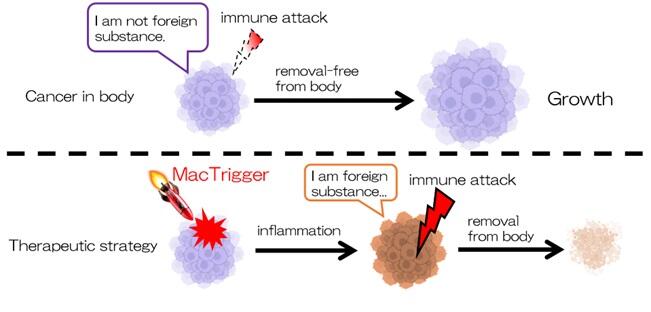In this newly developed method, inflammation is triggered in cancer tissue, which is then attacked by the body's immune cells. The research group made up of Assistant Professor Teruki Nii, Professor Yoshiki Katayama, and graduate student Kenta Tanito of the Graduate School of Engineering, Kyushu University, developed the world's first cellular drug, "MacTrigger," which induces an inflammatory environment in cancer tissue. The concept of using macrophages to activate the body's defense mechanisms for eliminating foreign substances, instead of attacking cancer, is entirely novel. Nii stated, "If possible, we would like to try and start clinical trials within 10 years." The result was published in the Journal of Controlled Release.

Provided by Kyushu University
Cancer cells release various substances to avoid being attacked by the body's immune cells. Although PD1 inhibitors prevent such immune evasion, their efficacy varies markedly among patients. The research group focused on macrophages, a type of immune cells. Macrophages actively accumulate in cancer tissues, where they are polarized from the normal type (M0 type) to the anti‐inflammatory type (M2 type). Benefitting from the characteristics of macrophages, the research group has developed a genetically modified macrophage, MacTrigger, which releases TNFα, an inflammatory substance, once the cell is polarized into the M2 type. "After screening various inflammatory substances, we believed that TNFα was the best option," Nii commented, "this is because TNFα is the substance first secreted by cells upon injury."
MacTrigger is programmed to disappear within about 4 days of encountering the cancer tissue. When it was injected into mouse models of colorectal cancer, the anticancer effect was confirmed after the 8th day. Specifically, the abundance of natural killer cells (NK cells) in the tumor increased from approximately 1% to 5%, and killer T cells increased from approximately 6% to 15%.
Consequently, by the 16th day after administration, the tumor volume in the treated group was reduced to about one third of that of the untreated group, and the survival rate, which was 20% in the untreated mice, increased to 100% with MacTrigger treatment.
However, since it is extremely dangerous if such substances exhibit inflammatory function throughout the body, a locking function was attached to prevent over-release of the TNFα plasmid, to ensure that MacTrigger worked in cancer tissues alone, except if the amount of the TNFα exceeds a certain amount. In the absence of the locking function, enlargement of the liver and an increase in the AST liver enzyme level in the blood were observed. Nevertheless, these side effects could be avoided if the locking function was used.
Macrophages have not received much attention as a cellular medicine to date, owing to their low gene‐transfer rate. The research group examined several gene recombination methods to increase the efficiency of gene transfer to macrophages, and by selecting gene‐transferred cells through drug selection, they successfully obtained a therapeutic level, as much as 1 million, of such cells.
Nii continued, "In order to apply this approach to actual clinical treatment, we have to reduce the number of cells required. We are also investigating if it is possible to produce MacTrigger from blood monocytes. In future, we would like to develop MacTrigger from blood samples so that it can be used for cancer treatment."
Journal Information
Publication: Journal of Controlled Release
Title: Engineered macrophages acting as a trigger to induce inflammation only in tumor tissues
DOI: 10.1016/j.jconrel.2023.04.010
This article has been translated by JST with permission from The Science News Ltd. (https://sci-news.co.jp/). Unauthorized reproduction of the article and photographs is prohibited.




